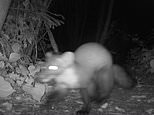
Pine marten is spotted in London for the first time in more than 100 YEARS – raising hopes for the critically endangered speciesThe pine marten was once Britain’s second most common carnivoreBut loss of habitat and persecution led the animal to the brink of extinctionNow, a pine marten has unexpectedly been sighted in south-west London
A pine marten has been spotted in London for the first time since the late 19th century.
The pine marten was once Britain’s second most common carnivore.
But loss of habitat and persecution by the Victorians, who shot pine martens for sport and trapped them for their fur, led the animal to the brink of extinction in England.
Now, however, a critically endangered pine marten has unexpectedly been sighted in a south-west London woodland.
A pine marten has been spotted in London for the first time since the late 19th century
The pine marten was once Britain’s second most common carnivore. But loss of habitat and persecution by the Victorians, who shot pine martens for sport and trapped them for their fur, led the animal to the brink of extinction in England
What are pine martens?
An elusive mustelid, the pine marten is mostly found in the north of the UK, particularly Scotland.
It prefers woodland habitats, climbing very well and living in tree holes, old squirrel dreys or even old bird nests.
It feeds on small rodents, birds, eggs, insects and fruit, and can even be encouraged to visit birdtables laden with peanuts and raisins.
During the summer mating season, they make shrill, cat-like calls.
The following spring, the female will have a litter of between one to five kits, which are independent by autumn.
Source: Wildlife Trusts
The return of an animal absent from the capital for more than a century was discovered through a hidden wildlife camera installed by international conservation charity the Zoological Society of London (ZSL).
The camera was used to monitor hedgehogs, as part of the London HogWatch Project.
The project’s research assistant, Kate Scott-Gatty, said: ‘As part of our ongoing hedgehog monitoring work, we deploy camera traps across woodlands.
‘In this area, these are usually set off by the movement of common species such as foxes and badgers, so you can imagine our surprise at seeing a pine marten – a species usually only glimpsed in Scotland and northern England.’
It is not known how the pine marten reached the urban woodland, with the nearest known population living more than 70 miles away in the New Forest in Hampshire.
Conservationists have suspected the animal caught on camera may have been released into the area.
Pine martens are generally restricted to northern and central Scotland, with some very small populations in northern England, the New Forest and Wales.
Dr Chris Carbone, senior research fellow at ZSL’s Institute of Zoology, said: ‘The return of wildlife to an area can be positive – it might mean that habitat quality is improving, or natural food sources are increasing – but it’s important we understand more.
‘Any species reintroductions should only be carried out by professionals, with the appropriate checks in place – from assessing habitat suitability to screening for illnesses.’
Elliot Newton, biodiversity officer at the Royal Borough of Kingston upon Thames, said: ‘We are so excited to have found such a beautiful and elusive mammal on cameras funded by Kingston Council as part of the HogWatch project.
‘Across other European countries, pine martens are recorded in urban settings.
‘The individual caught on our cameras is looking in good health and is a very welcome addition to our local fauna.’
The return of an animal absent from the capital for more than a century was discovered through a hidden wildlife camera installed by international conservation charity the Zoological Society of London (ZSL)
The camera was used to monitor hedgehogs, as part of the London HogWatch Project
In July, it was revealed that pine martens could be reintroduced to the south-west of England following a 150-year absence.
A coalition of conservation organisations, including the National Trust, the Devon Wildlife Trust and the Woodland Trust, hope the nocturnal mammals could be released as early as autumn next year.
Pine martens are a tool in the battle to save Britain’s native red squirrel, as they tend to hunt grey squirrels more than red ones.
The creatures are omnivores, feeding on whatever is available at the time of year including voles, rabbits, fungi, berries and small birds.
Share or comment on this article:
Source link
CHECK OUT: Top Travel Destinations
READ MORE: Travel News



